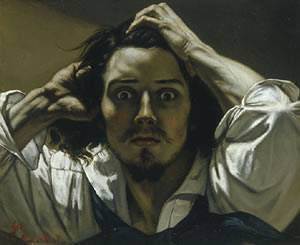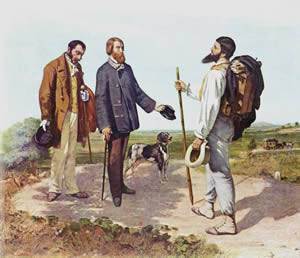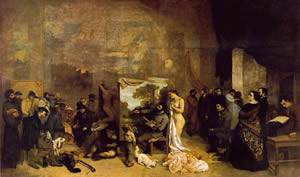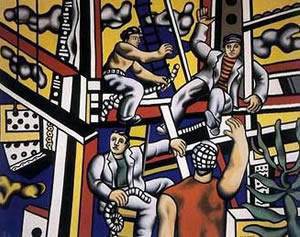
“The desperate man” is a stunning self-portrait by Courbet

Courbet: “The meeting: Bonjour, Monsieur Courbet”

Two visitors in front of the controversial “L’origine du monde” at the Orsay in Paris

Courbet: Atelier du peintre
GUSTAVE COURBET
New York, Metropolitan Museum – February 27-May 18, 2008
Previously in Paris, Galeries Nationales du Grand Palais – until January 28 2008
]]>
“It is impossible to tell you all the insults my painting of this year has won me, but I don’t care, for when I am no longer controversial I will no longer be important.”
Gustave Courbet, in a letter to his parents [June 12, 1852]
A pioneering figure in the history of modernism and one of the major artists of mid-19th-century France, Gustave Courbet (1819-1877) was constantly at odds with authority. He rejected artistic convention, challenged academic norms, and created artworks that scandalized the public. By rebelling against tradition, he paved the way for the Impressionists and, through them, modern art.
More than 130 oil paintings and works on paper by the provocative artist, brought together from museums and private collections in Europe and the United States, will be displayed at The Metropolitan Museum of Art this spring in his first full retrospective in more than 30 years. The landmark traveling exhibition Gustave Courbet explores his career in all media and includes a selection of 19th-century photographs that relate to his work, especially his landscapes and nudes.
The exhibition is made possible in part by the Janice H. Levin Fund.
It was organized by The Metropolitan Museum of Art, New York, the Réunion des Musées Nationaux and the Musée d’Orsay, Paris, and the Communauté d’agglomération de Montpellier/Musée Fabre, Montpellier.
Gary Tinterow, the Engelhard Curator in Charge of the Department of Nineteenth-Century, Modern, and Contemporary Art at the Metropolitan, commented: “Courbet was one of the first painters to cultivate the image of the rebellious artist. Never one to avoid controversy, he disregarded the expectations of his family, challenged the conservatism of the Academy, and bristled against the strictures of society. Even his politics were radical. And for most of his career, this notoriety served him well, attracting clients and influencing other artists of his generation. The exhibition will give today’s public a rare opportunity to rediscover this complex artist and chart, through works he created some 150 years ago, the early history of modern art.”
Exhibition Overview
The exhibition is arranged chronologically, with some galleries devoted to specific themes: early self-portraits, Ornans paintings, nudes, and Courbet and photography.
The exhibition will include several of Courbet’s seminal paintings from the early 1850s, which depict the customs of Ornans. Exhibited at the Salon of 1852, Young Ladies of the Village, a pastoral image of his sisters’ encounter with a peasant girl in a valley near Ornans, was criticized for the unattractiveness of its protagonists and its apparent disregard for perspective (1851-52, The Metropolitan Museum of Art). The Meeting: Bonjour Monsieur Courbet represents what is likely an imagined exchange between the noted collector of 19th-century art Alfred Bruyas and the artist, who had come to visit him in Montpellier (1854, Musée Fabre, Montpellier).
Also on view will be a selection of Courbet’s nudes, revealing the modernity of his approach to the genre. Idealized female nudes proliferated at the Salons in Paris during the Second Empire, and Courbet challenged the status quo – and also scandalized the public at the Salon of 1866 – with his sensuous and provocative Woman with a Parrot (1865-66, The Metropolitan Museum of Art). By censuring the artist’s taste and the model’s discarded clothes and disheveled hair, the critics made it clear that they were unsettled by the work’s undisguised contemporaneity.
Courbet was also an innovative landscape painter. His painterly and expressive renderings of Ornans and its surroundings, notably his series of paintings of the grotto at the source of the Loue River and the wooded stream of the Puits-Noir (National Gallery of Art, Washington, and The Baltimore Museum of Art), as well as his views of the coastline of Normandy (Musée Fabre, Montpellier, and Philadelphia Museum of Art), signal his radical approach to landscape painting. These works brought Courbet critical and popular success, as did his hunting scenes, which he began painting in the late 1850s.
Portraiture engaged Courbet throughout his career, and is represented by an unprecedented selection of the artist’s early self-portraits in various guises. A highlight is the astonishing self-portrait The Desperate Man (1844-45, Private Collection), shown in the United States for the first time. He also painted numerous portraits of his family and friends, including his sister Juliette Courbet (1845; Petit Palais) and the posthumous portrait of his friend, the philosopher Pierre-Joseph Proudhon, with his children (1865-67, Petit Palais, Paris).
The Artist
Gustave Courbet was born into an affluent landowning family in the village of Ornans, near the Swiss border. He studied at the Royal College in the nearby town of Besançon and, in 1840, was sent to Paris to study law. Defying his father, he pursued an artistic career instead and learned by copying masterpieces in the Louvre.
In the 1840s and early 1850s, Courbet’s paintings were accepted into the official Salon – the annual juried exhibition administered by the French government and the Academy of Fine Arts. But, as he matured as an artist, he spurned the historical subjects prized by the Academy and painted scenes of modern life rendered in an emphatically realistic style, shocking his contemporaries. In 1855, disgruntled at his rejection by the Salon jury, Courbet constructed a Pavilion of Realism within sight of the official Salon in which he displayed a one-man show of his works, accompanied by a manifesto that proclaimed his artistic philosophy. The decade that followed witnessed his triumph as the leader of the realist school.
Courbet joined the Paris Commune of 1871 and – following the collapse of the revolutionary government – was accused of complicity in the destruction of the Vendôme column, ordered to pay a huge fine for its reconstruction, and imprisoned. In 1873, he fled to Switzerland, where he spent his remaining years in exile.
Follow us on:


